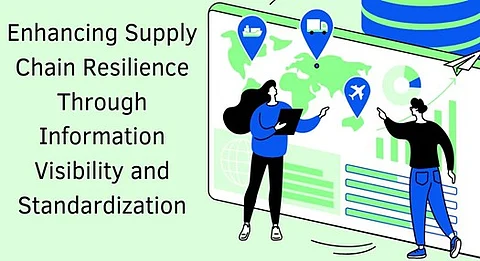

In today's complex business environment, supply chain resilience is crucial for maintaining a competitive edge. Information visibility and standardization are key drivers of resilience. This article, authored by Madhusudan Sharma Vadigicherla, explores the role of collaborative approaches, especially production forecast visibility, in building more robust and agile supply chains.
Supply chains today are facing unprecedented challenges, including disruptions from global events, fluctuating demands, and geopolitical tensions. In response, businesses are increasingly turning to information visibility as a crucial strategy for resilience. Enhanced visibility across the supply chain enables companies to monitor real-time data, improve decision-making, and anticipate potential disruptions before they occur.
By integrating information across different tiers of the supply chain, businesses can gain a comprehensive view of operations. This transparency helps mitigate risks, optimize inventory management, and improve capacity planning. As industries continue to face volatility, the ability to track and adjust to changes quickly becomes a strategic advantage.
While information visibility is essential, standardization plays a pivotal role in ensuring that data is not only visible but also usable across different stakeholders in the supply chain. Standardizing processes and systems helps streamline operations, reduce discrepancies, and enhance coordination between partners. By aligning production schedules, demand forecasts, and inventory management practices, companies can ensure smooth operations even when faced with unexpected disruptions.
Standardization also reduces the complexity of supply chain management, particularly when dealing with multiple suppliers and partners spread across different regions. It allows organizations to create a unified approach to forecasting, procurement, and material planning, all while improving response times and reducing communication delays.
Collaborative forecasting plays a crucial role in enhancing supply chain resilience by aligning production forecasts between companies and suppliers. This shared visibility improves capacity planning, material procurement, and inventory management, reducing stockouts and overstocking. By providing accurate forecasts, it supports long-term planning, optimizes production schedules, and strengthens supplier relationships. Collaborative forecasting also helps businesses anticipate demand shifts, adjust to sudden surges or shortages, and remain agile during disruptions. Ultimately, this approach mitigates risks and ensures that companies can respond effectively to changes in demand and supply, boosting overall supply chain performance.
Despite the clear benefits of collaborative forecasting and information visibility, challenges remain. Data integration and quality issues can arise when consolidating information from various sources, impacting system effectiveness. Resistance to change from stakeholders used to traditional methods can slow adoption. To overcome these, companies must invest in data governance, improve data quality, and foster collaboration across departments and partners. Early employee training and stakeholder engagement are essential for overcoming resistance and ensuring the success of collaborative forecasting initiatives.
Technology is essential for enhancing information visibility and standardization across the supply chain. Advanced analytics, cloud computing, and automation help companies capture, store, and process large data volumes, providing real-time insights. These technologies enable seamless integration between partners, reducing system incompatibility. Additionally, emerging technologies like blockchain improve data security and transparency, ensuring reliable, tamper-proof information. This technological integration creates a more resilient, efficient supply chain, capable of adapting to market changes and mitigating risks.
Supply chain resilience is an ongoing process that demands continuous evaluation and adaptation. Standardizing processes and improving information visibility are essential components of this strategy. By using metrics to track forecasting accuracy and operational efficiency, companies can identify areas for improvement. Ongoing collaboration and enhancements in forecasting and risk management ensure that the supply chain remains adaptable, better prepared for disruptions, and capable of quick recovery, ultimately improving overall performance and resilience in the face of unforeseen challenges.
In conclusion, Madhusudan Sharma Vadigicherla highlights that information visibility and standardization are essential in enhancing supply chain resilience. As businesses face increasing global challenges, adopting collaborative approaches and leveraging technology to improve forecasting accuracy and operational coordination is key. By standardizing processes and improving information sharing, companies can build more resilient, agile, and efficient supply chains, as outlined in this study.
